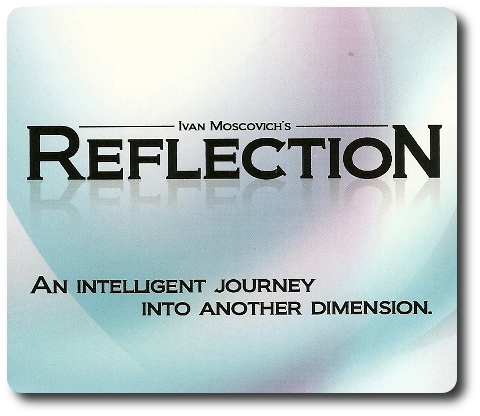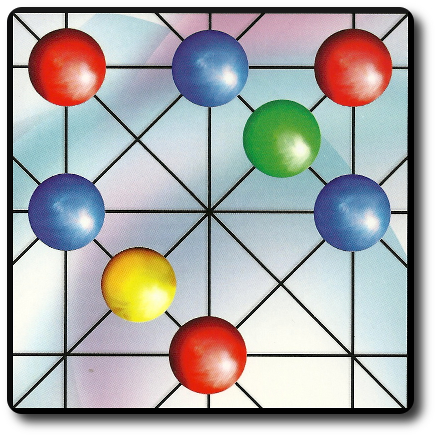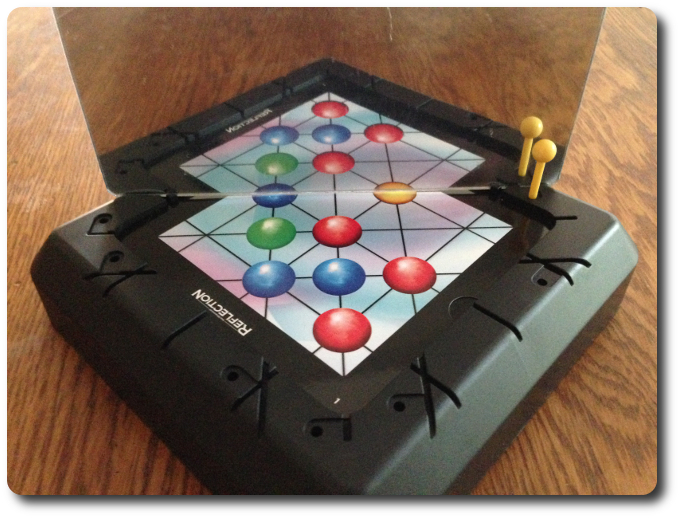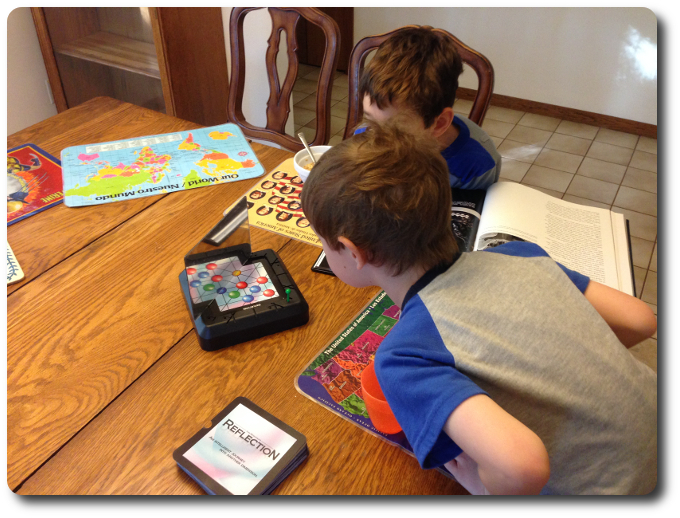
The Basics:
- For ages 6 and up (publisher suggests 8+)
- For 2 to 4 players
- Variable game play length
Geek Skills:
- Counting & Math
- Logical & Critical Decision Making
- Pattern/Color Matching
- Visuospatial Skills
Learning Curve:
- Child – Easy
- Adult – Easy
Theme & Narrative:
- Reflect on the best way to score as many points as possible
Endorsements:
- Gamer Geek approved!
- Parent Geek approved!
- Child Geek approved!
Overview
Aidan Gillen, an actor currently best known for his role as Petyr Baelish in the HBO Game of Thrones series, said “I don’t do a lot of reflecting. I’m usually about getting on with it.” Some of us stop and reflect on our choices and what it means, while others clearly do not. Regardless of your personal approach to life, this game is all about reflecting. Expect hindsight to smack you in the face a few times.
Reflection, designed by Ivan Moscovich and published by Fat Brain Toys, is comprised of 60 Challenge cards, 4 pegs (in 4 different colors, 1 per player), 1 mirror (yes, a mirror), 1 playing platform, and 1 score pad. The Challenge cards are about as durable as your standard playing card and square. The playing platform is made entirely of plastic and contains a box that holds the Challenge cards and pegs. When attached to the playing platform, it allows players to turn the platform like a Lazy Susan. The mirror reminds me of the one I had in my high school locker. Gotta look good for the ladies…who didn’t pay attention to me… Not included in the game, but necessary to play, is a pen or pencil.
Game Set Up
To set up the game, first place the playing platform in the middle of the playing area.
Second, shuffle the Challenge cards and place them, face-down, next to the playing platform.
Third, each player selects 1 peg color. Any pegs not selected should be returned to the game box.
Fourth, give 1 player the score pad. This player is referred to as the Score Keeper. They will keep track of players’ scores throughout the game.
That’s it for game set up. Time to get a new perspective of things.
A Matter of Perspective
Reflection is played in rounds for a total of 10 rounds of play. A single round is summarized here.
Step 1: Select a Challenge Card
The top-most Challenge card is drawn and placed, face-up, on the playing platform. There is a shallow recess in the middle of the playing platform where the card easily sits. The orientation of the Challenge card is not important. Each Challenge card has illustrations of colored spheres and lines that intersect. The lines are referred to as “axes” (that’s the plural of “axis” – I had to look it up).

Step 2: Quick Observation
All the players should now review the Challenge card. This is where the game gets really interesting and difficult. The goal is to determine which axis (a single straight line on the Challenge card) will score the most points. To score points, the players will be using the mirror to create a reflection of the spheres on the Challenge card.
Once the player determines which axis will provide a reflection that scores as many points as possible, they place their peg in one of the 12 holes found on the border of the playing platform. This secures the axis for the player. Opponents cannot select the same axis.
Step 3: Quiet Reflection
After all the players have placed their pegs, each player now takes a turn to place the mirror in the slot next to their selected peg hole. The orientation of the mirror is up to the player to decide. The player now determines their score. When calculating points, the spheres on the Challenge card and the spheres being reflected in the mirror are used! I suggest you calculate the score as follows.
- Count all the red spheres
- Count all the blue spheres
- Calculate the difference between the red and blue spheres by subtracting the smaller of the two numbers from the larger number
- Add 1 to the result for each green sphere
- Subtract 1 to the result for each yellow sphere
For example, if the player counted 4 blue spheres, 3 red spheres, 2 green spheres, and 1 yellow sphere, their total score for the round would be 2.
- 4 blue spheres – 3 red spheres = 1
- 1 + 2 green spheres = 3
- 3 – 1 yellow sphere = 2
Let’s look at a visual example.

The mirror placement gives the yellow peg player the following total number of sphere:
- Red spheres = 6
- Blue spheres = 5
- Green spheres = 2
- Yellow spheres = 1
The total points for the player with the yellow peg is 2. See it now?
Note: There was some debate from our players regarding how the points were to be counted. The rules state “the difference in number between red and blue spheres”. Some players understood that to mean that it was always RED – BLUE. This could lead to negative numbers. For example, 2 red – 4 blue = -2. I don’t think it matters as long as all the players understand HOW the spheres are to be counted before the game is played. I personally like my interpretation of the rules because it makes for easier math for the Child Geeks.
In summary. Green is good, yellow is bad, and you want more red than blue (or vice versa).
Once the players calculates their score, the Score Keeper writes it down on the score pad and the next player calculates their points by positioning the mirror on the axis they selected. After all the players have calculated their score, the pegs are returned to the players and the Challenge card is discarded. A new round of play now begins.
Winning the Game
The game ends after the 10th round of play. The Score Keeper should now calculate each player’s total. The player with the highest score wins the game.
House Rule
We added a sand timer to our game (one is not included) to keep everyone focused and to reduce the time spent during the second step in a round. When used with the Child Geeks, it caused more frustration than what we thought necessary and removed it. For the Parent and Gamer Geeks, it was perfect. Try adding a sand timer (or any 30-second timer) to the game and see if you like the results.
House Variants
Play to Score
Instead of playing a total of 10 rounds of play, a few of us wanted to play to a certain score. For example, the first person to score 50 or more points.
Play More or Fewer Rounds
Depending on the number of players in your game, 10 rounds could go very quickly or take longer than you want. Simply adjust the number of rounds by reducing or adding the total in the game to meet your needs.
Solo Play
My 6-year-old found that he could play Reflection as a solitaire game by attempting to beat a score in 5 or less rounds of play. According to my 6-year-old, a solitaire game should be scored as follows.
- A score of 20 or more = awesome
- A score of 15 or more = good
- A score of 10 ore more = meh
- A score of 5 or more = pick a new game
To learn more about Reflection, visit the game’s web page.
Prediction
Reflection is a Real-Time game and a Puzzle game combined. This means players will be forced to think faster than they might be comfortable with and competing with others who could be distracting. Not that any of this is bad, but some players like Puzzle games that allow them to deeply concentrate, which you cannot do when playing a Real-Time game. Likewise, players who enjoy Real-Time games want an experience that requires quick thinking and action, not deep focused thought.
Therefor, if actor Aidan Gillen was playing this game, I don’t think he’d enjoy the puzzle aspect, but he would like the Real-Time game play. I’m at a bit of a loss when it comes to predicting how a game is going to be received when it combines two game types that often are polar opposites. But let’s give it a shot, anyway.
For the Child Geeks, I think they’ll enjoy Reflection. It’s a new and interesting way to play a game. The only other game the Child Geeks have played that included mirrors was Laser Battle. They enjoyed that and they will most likely enjoy the uniqueness of the game play. Whether or not they win is not really the point. What does count is if they have fun.
For the Parent and Gamer Geeks, there is enough of a game and a challenge here to be entertaining. The game play itself is focused and casual. This should appeal to the Parent Geeks. Since a competitive player does need to put some very quick and real thought into their axis selection, I think we’ll see some (not all) Gamer Geeks enjoy Reflection as a game filler.
Teaching Reflection is best done by example. Place a Challenge card, point out the axes, and then slide in a mirror. Show how the spheres both in the reflection and on the Challenge card are counted and scored. That’s all you should have to do, but do let the first couple of rounds of play be a bit slower to allow players to get the hang of it. Note that this game doesn’t require any reading but does require math. Younger Child Geeks should have no problem playing. Those who have difficulty distinguishing colors will be at a serious disadvantage.
And so, after teaching Reflection to my 3 little geeks, I asked them their thoughts on the game so far.
“Neat idea! I like how you have to think like a mirror.” ~ Liam (age 9)
“This is going to be a hard game to win, Daddy.” ~ Nyhus (age 6)
“I don’t understand it.” Ronan (age 4)
To think like a mirror….I like that. My 6-year-old can already see the challenge ahead of him and my 4-year-old remains confused. Let’s play Reflection and see how it goes.
Final Word
The Child Geeks were slow to catch on, but they understood the game well enough to be competitive. I hesitate to suggest that the learning curve for Reflection is anything but “easy”, since the game rules are very simple and straight forward. The difficult part is attempting to “think like a mirror” (to quote my oldest son) and get the most points. That makes the game difficult to win, not to play. As for my 4-year-old, he lost interest and walked away. My 6 and 9-year-old loved it. They found it very interesting and were always excited to count their spheres. According to one Child Geek, “What I really like about this game is that you never really know what you have until you place the mirror. It feels like a surprise every time.” A surprise, I must add, the Child Geeks enjoyed regardless of the points they earned. When all the games were played, the Child Geeks reflected on their experience and decided Reflection was well worth their time.

The perfect game for the Child Geeks at breakfast
The Parent Geeks were also a bit unsure about how the game was played until they completed the first round. According to one Parent Geek, “Oh, now I get it! I was a bit confused at first, but now I see how I need to change my thinking.” This quote does an excellent job of encapsulating the first round experience for the majority of Parent Geeks (and pretty much all players). Until the game is actually played, there will be some open questions that cannot be answered by anything short of experience. All the Parent Geeks thought Reflection was a unique game, was fun, and proved to be challenging. Another Parent Geek said, “It’s not a hard game, but you have to really think fast if you want to win!” All the Parent Geeks voted to approve Reflection.
The Gamer Geeks thought Reflection was a pretty interesting concept and a new twist that they enjoyed. The game’s initial pitch was met with withe lukewarm enthusiasm or excited optimism. Sometimes both. The Gamer Geeks don’t usually go for Puzzle games, but they do enjoy the challenge of Real-Time games. They thought Reflection did a pretty good job of mashing the two together, for the most part. According to one Gamer Geek, “I like the game’s concept, but it’s not a game I would want to play.” Another Gamer Geek said, “Very interesting! I wouldn’t mind playing this to kill time or as a light filler.” When all the games were over, the Gamer Geeks agreed that Reflection was worth putting on their gaming table.
Well, holy cow. All three of our groups enjoyed Reflection, which means it wins our Father Geek Seal of Approval. I’m most pleased it did, as I rather like this little game. I do wonder if the puzzles will become easier if I start to recognize the patterns on the Challenge cards, but I don’t think that’ll happen. The Challenge cards are always randomized and the energy level of the table is always different. I might have more time to think about some cards in one game and much less in another. Besides, I can think of 100 other things I’d rather memorize first before I put any energy into memorizing the Challenge cards.
Including a sand timer was a godsend for this game. If you don’t have some sort of method of keeping a round well-paced, nothing is stopping players from taking their time. “Time” is not something players should have a lot of when playing against opponents. That’s part of the fun and the challenge. If you don’t feel the pressure to think fast, I think you’ll find that Reflection falls a bit flat.
If you like puzzles and games where everyone has to play at the same time, do take a moment to reflect if Reflection is for you.
This game was given to Father Geek as a review copy. Father Geek was not paid, bribed, wined, dined, or threatened in vain hopes of influencing this review. Such is the statuesque and legendary integrity of Father Geek.




Pingback: Today in Board Games Issue #176 - Splendor, Designer Wisdom, Minion Review - Today in Board Games
Pingback: In Review: Father Geek’s Monthly Newsletter (May 2014) » Father Geek
Pingback: In Review: Father Geek’s Monthly Newsletter (June 2014) » Father Geek